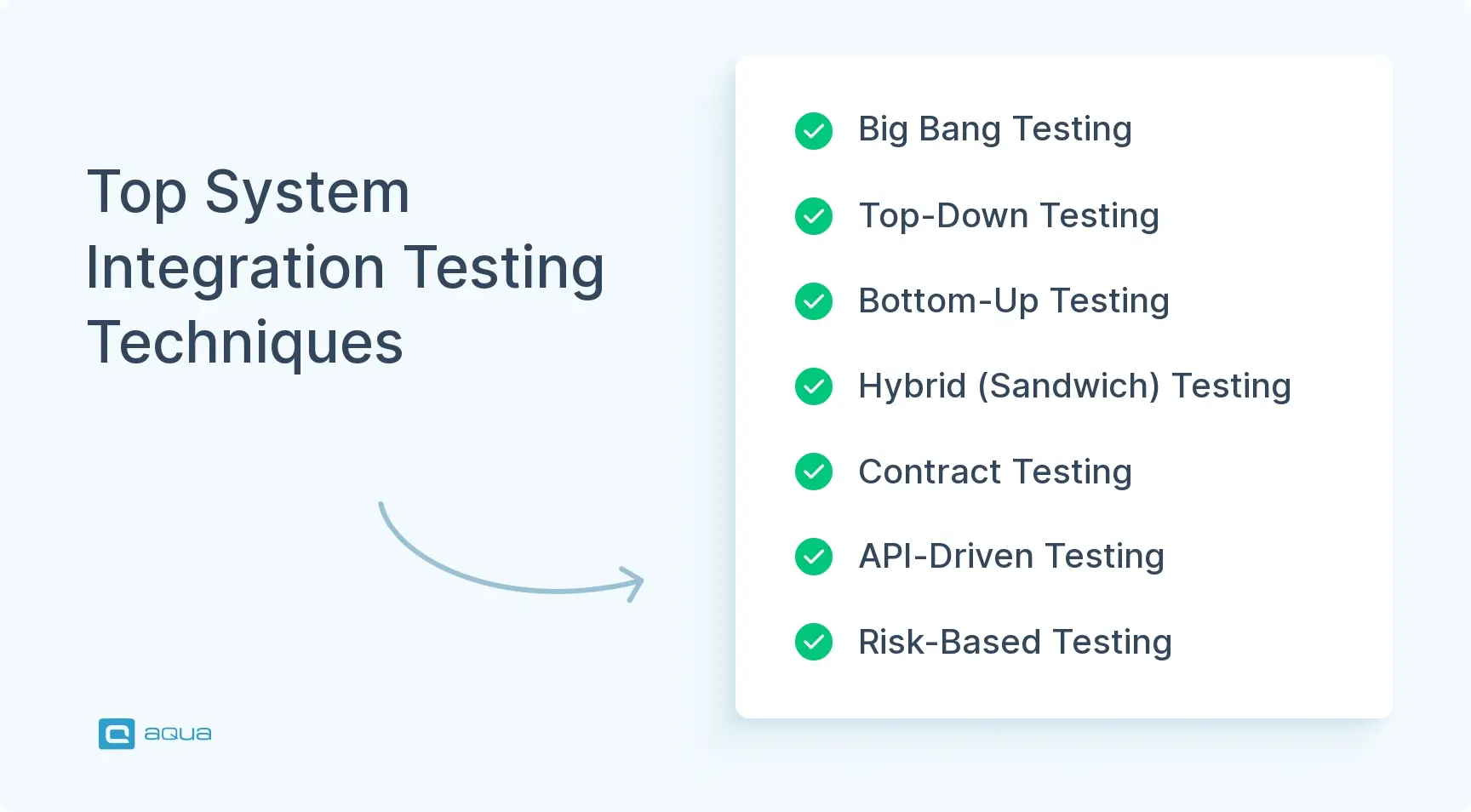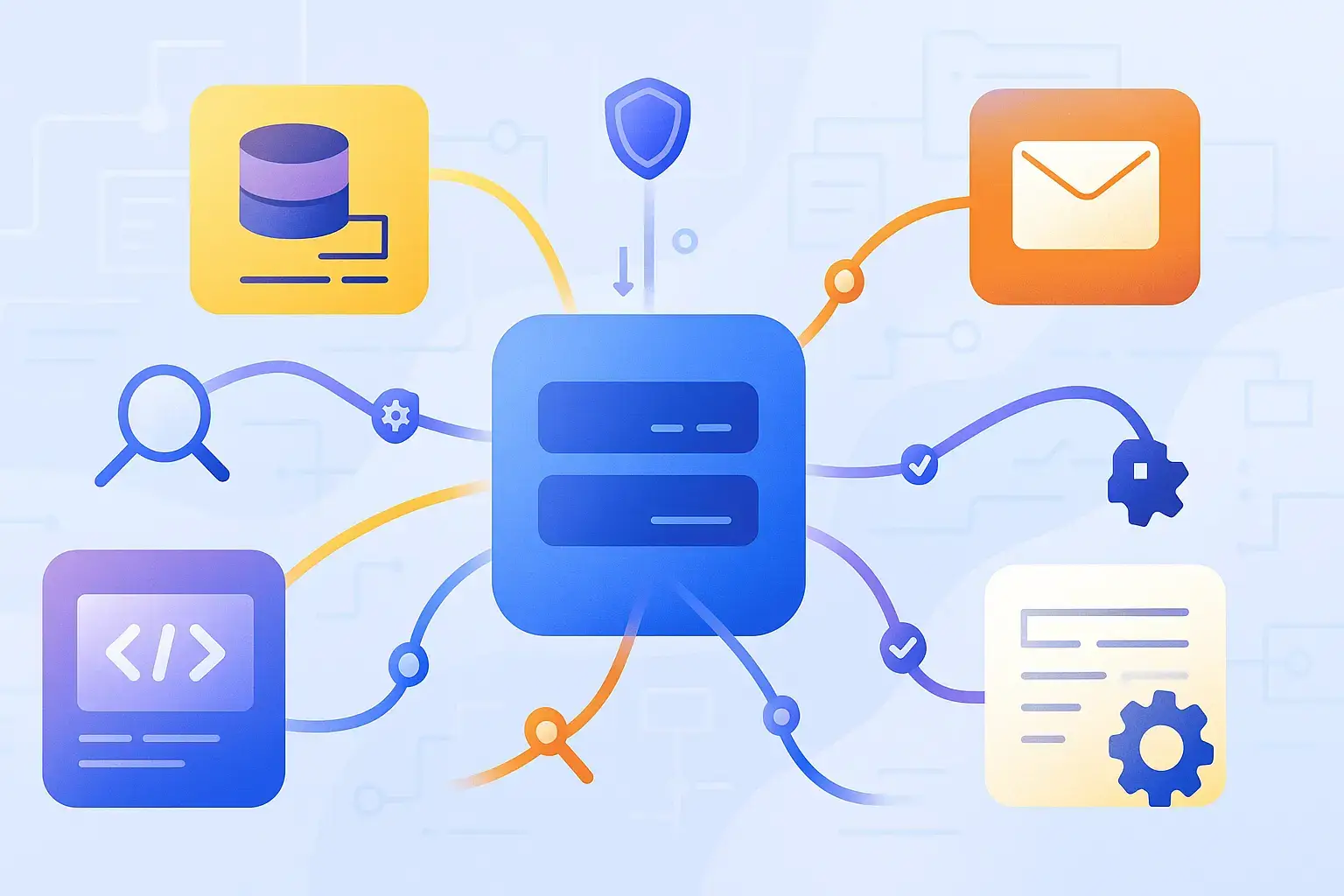What is System Integration Testing (SIT)?
Let’s say your team just finished unit testing all the core components of a new feature. Everything looks clean on paper. But the moment those parts start interacting, like APIs calling APIs, data flowing across services, something breaks. But what?
System Integration Testing is the stage where you stop testing components in isolation and start testing how they behave when they work together. It sits between unit testing and end-to-end testing and focuses purely on the communication between integrated parts of your system.
Think of it like this: unit tests check that every cog in the machine turns correctly. SIT checks whether those cogs actually connect and move in sync when the system runs.
Here’s a concrete example. In an e-commerce platform, SIT would verify things like:
- The product catalogue sends correct data to the shopping cart
- The checkout module passes transactions properly to the payment gateway
- The inventory updates after a successful purchase
- The notification service sends out the right confirmation emails
You’re not testing whether the catalogue or payment service works; that’s already been done. You’re testing whether they work together without losing data, failing silently, or crashing under the weight of miscommunication.
System integration testing tends to reveal issues that unit tests can’t touch:
- Data formats that don’t align
- Misconfigured API endpoints
- Authentication hiccups between services
- Race conditions or bad timing
- Environment config issues you didn’t see in dev
So if you’ve ever had a deployment go sideways and thought, “But it worked in isolation,” SIT is the answer to that problem. It’s how you catch integration bugs before they hit production and cause real damage.
Importance of System Integration Testing
Once you understand what SIT is, the next obvious question is: Why should I care? You’re already testing your code, reviewing pull requests, maybe even automating a few E2E flows. Isn’t that enough?
Not even close.
The harsh truth is this: most real-world bugs don’t happen because a single function fails; they happen when two or more things don’t play nice together. And that’s exactly where system integration testing becomes a game-changer.
Let’s break down why SIT is a critical part of building software that doesn’t fall apart in production:
- It catches the bugs unit tests never will
You can test every function to death, but if one service expects camelCase and the other sends snake_case, guess what breaks? SIT uncovers the invisible friction between components that don’t quite understand each other. - It saves your team from fire drills at 2 a.m
Integration bugs are among the top causes of production failures. Testing those connections before you deploy means fewer emergency rollbacks, fewer angry messages from stakeholders, and a whole lot less stress. - It’s how you test what users actually experience
Your users don’t interact with isolated components; they go through full flows. Browsing. Adding to cart. Checking out. Integration testing validates that these flows work from start to finish, the way real people use your product. - It keeps your architecture honest
Diagrams look great until reality hits. SIT is where theory meets practice. It validates that your microservices, data pipelines, or event-driven workflows are actually doing what they’re supposed to do in the real system. - It boosts overall system stability
A system that’s only been tested in pieces is fragile. But once you start testing the glue, the protocols, formats, syncs, and timeouts, you catch issues early and build something that holds together under pressure.
Still not convinced?
Here’s a real-world example.
A financial services company once pushed a minor update to their authentication service. Just a small tweak; they added a new field to an API response. Seems harmless, right? But the downstream billing system couldn’t handle the new field and started failing silently. The issue wasn’t caught in unit or smoke tests. It caused a full-on production outage.
After that, the team added proper system integration testing to their release pipeline. The results?
They caught 37% more defects before release, and their production incidents dropped by over 50%.
Sometimes, all it takes to prevent the next major outage… is a test that checks whether your pieces actually fit together.
Making integration testing work at scale takes more than good intentions as it takes the right infrastructure, tooling, and visibility. Managing all those moving parts manually will quickly become overwhelming, especially as your systems grow more complex.
When dealing with system integration testing, having the right tools can make all the difference. This is where aqua cloud shines as your complete test management solution for integrated systems. With aqua, you can centralise both manual and automated test cases in one platform, ensuring comprehensive coverage across all integration points. The platform seamlessly connects with popular tools like Jira, Jenkins, and SoapUI through its robust API, allowing you to orchestrate end-to-end testing across different components without switching between multiple applications. What’s more, aqua’s AI capabilities can generate integration test cases by simply describing scenarios in plain language, saving up to 97% of your test creation time while maintaining complete traceability between requirements and tests to ensure no critical integration path goes untested.
Achieve 100% visibility and control over your system integration testing with aqua cloud
System Integration Testing Techniques
How Do You Actually Test the Integration?
Alright, so you’re sold on why system integration testing matters. The next question is: how do you actually do it? Because let’s face it, “just test how things work together” isn’t exactly helpful when you’re dealing with dozens of services, APIs, and data flows.
The good news? You’ve got options, and most teams don’t stick to just one. Here’s a breakdown of the most common (and most useful) techniques, depending on what kind of system you’re working with:
- Big Bang Testing
You plug everything in and test the whole thing as one big system. Fast to set up, but when something breaks, good luck figuring out where. Use it when all components are ready and time is tight, but don’t rely on it alone. - Top-Down Testing
Start with high-level modules and plug in the lower ones gradually. Great for spotting big-picture issues early. Just be ready to mock unfinished lower-level components with stubs. - Bottom-Up Testing
Flip it around: test the foundational components first, then move up. You’ll validate the guts of your system early on, but won’t see full workflows until later. - Hybrid (a.k.a. Sandwich) Testing
A practical middle ground: test the top and bottom layers in parallel and meet in the middle. More work to coordinate, but it offers quicker feedback across layers. - Contract Testing
Ideal for microservices. Instead of testing everything live, you verify that each service lives up to its agreed contract (expected requests/responses). It’s fast, isolated, and plays well in CI/CD pipelines. - API-Driven Testing
Focus on the APIs that glue your system together. Check that they speak the same language, return the right data, and fail gracefully when things go wrong. - Risk-Based Testing
Don’t have time to test every interaction? Prioritise what matters most. Focus on areas with the highest business risk or technical complexity. - Regression Integration Testing
Whenever something changes, re-test your existing integrations to make sure nothing got silently broken.

Infographics image to explain best techniques to perform system integration testing.
In real-world projects, you’ll likely mix and match these depending on your architecture, team setup, and deadlines. The trick is to be intentional; don’t just run tests because they’re “part of the plan.” Run the ones that catch what you’d never see coming until it’s too late.
Let your test strategy reflect how your system actually works in production, not just how it looks in a diagram.
Entry and Exit Criteria for SIT
Knowing when to start and when to conclude system integration testing is crucial for an effective testing process. Clear system integration testing entry and exit criteria help maintain quality standards and ensure the testing phase accomplishes its objectives.
Entry Criteria for System Integration Testing
| Category | Criteria | Description |
|---|---|---|
| Component Readiness | Unit Testing Complete | All individual components have passed their unit tests with acceptable coverage |
| Component Documentation | Interface specifications, data formats, and API documentation are available | |
| Environment | Test Environment Ready | Integration test environment is set up properly with all necessary configurations |
| Test Database Available | Test data is prepared and loaded into the database | |
| Required Services Available | All external services or mocked versions are available and accessible | |
| Test Planning | Integration Test Plan Approved | The SIT plan has been reviewed and approved by stakeholders |
| Test Cases Ready | Integration test cases have been prepared and reviewed | |
| Test Data Prepared | Test data sets for integration scenarios are available | |
| Tools & Resources | Testing Tools Configured | Required testing tools and frameworks are installed and configured |
| Test Team Ready | Testing team has been briefed and is available to perform testing |
Exit Criteria for System Integration Testing
| Category | Criteria | Description |
|---|---|---|
| Test Execution | All Planned Tests Executed | All identified integration test cases have been executed |
| Critical Path Testing Complete | All business-critical integration paths have been tested | |
| Test Coverage Achieved | Agreed coverage metrics have been met (e.g., 90% of interfaces tested) | |
| Defect Status | Critical Defects Resolved | All critical and high-severity integration defects have been fixed and retested |
| Acceptable Defect Count | Number of open medium/low defects is below the agreed threshold | |
| Regression Testing Passed | Regression tests show no new integration issues introduced by fixes | |
| Documentation | Test Results Documented | Test results, including metrics and defect statistics, are documented |
| Known Issues Documented | Any remaining issues are documented with workarounds if available | |
| Approval | Stakeholder Sign-Off | Key stakeholders have reviewed and approved test results |
| Go/No-Go Decision Made | Decision to proceed to system testing has been formally made |
When you define these criteria properly and stick to them, you create a safety net for your testing process. It means you’re not jumping the gun or calling it done just because a deadline is looming. You’re setting clear expectations for what “ready for testing” and “ready to release” actually mean.
It might feel like overhead, especially under pressure. But skipping this step is how integration bugs slip through and land in production. So treat your entry and exit criteria as guardrails, not paperwork. They’re there to protect your team from chaos and your users from broken features.
Creating a System Integration Test Plan
You can’t just wing integration testing, especially when multiple systems, teams, and environments are involved. A solid test plan is what turns chaos into clarity. It gives your team direction, sets expectations, and makes sure no critical connection goes untested.
Here’s what a practical system integration test plan should include:
- Scope & Objectives
Define what you’re testing, what you’re not, and why. List key components, interfaces, and testing goals so everyone’s aligned from day one. - Integration Map
Use a simple system diagram to show how components connect. Highlight dependencies, data flows, and high-risk paths that need extra attention. - Environment Setup
Document what needs to be in place: infrastructure, test data, third-party systems, credentials. If a service isn’t live yet, decide what gets mocked. - Test Strategy
Outline your approach: big bang vs. incremental, contract testing, regression strategy, tools you’ll use, and how you’ll handle flaky integrations. - Test Scenarios
Focus on real flows. For example:
Complete Purchase Flow
- Product gets added to cart
- Cart flows into checkout
- Payment gets processed
- Order is created, inventory updated
- Confirmation is sent
Cover both happy paths and failure cases.
- Roles & Responsibilities
List who’s doing what: testers, devs, SMEs, and external contacts. Make sure someone owns each component and integration. - Defect Handling
Define how bugs are logged, prioritised, and tracked. What counts as a blocker? What gets retested, and when? - Risks & Contingencies
Note any known risks, tricky integrations, or unstable environments, and how you’ll handle surprises when they come up.
Keep the plan simple, useful, and easy to update. It’s your blueprint for testing what actually matters. Better yet, turn it into a reusable template your team can adapt for future projects.
Executing System Integration Testing: A Step-by-Step Guide
Once your test plan is ready, it’s time to bring it to life. Integration testing is where theory meets reality, and your system proves whether it can truly work as a whole.
1. Set Up the Environment Properly
Start by preparing a test environment that mirrors production as closely as possible. Make sure all required services are deployed, the test data is loaded, and external dependencies are either available or mocked. A few simple connectivity checks can save hours of debugging later.
2. Prepare Test Data and Automation
Your test results are only as good as the data behind them. Create realistic datasets that reflect how users actually interact with your system. Wherever possible, use automation to repeat tests efficiently and set up proper logging to catch anything that fails quietly.
3. Test Interfaces One by One
Begin with individual interface checks before running full workflows. Make sure each service can communicate with the others, data formats match, and errors are handled properly. This step helps you isolate issues early, before they get buried in complex flows.
4. Run End-to-End Workflows
Now test the entire journey—from one component to the next, and all the way through. Focus first on the critical paths that power real user experiences, then move to edge cases. Keep an eye on data consistency and system behaviour across each handoff.
5. Log and Prioritise Defects
Every issue you uncover should be logged with enough detail for someone else to pick it up and fix it. Classify bugs by impact and severity, and clearly identify which component is responsible. The more context you give, the faster the fix.
6. Re-test and Run Regressions
After fixes are applied, go back and re-run the original tests to confirm everything works as expected. Then run regression tests to make sure new changes haven’t broken anything that was working before. If you can automate this part, even better.
7. Report and Share Results
Wrap things up with clear reporting that shows what passed, what failed, and what needs attention. Use the results to spot patterns or repeated problem areas. Share findings with stakeholders early so there are no surprises at release time.
Example: Testing a User Registration Flow
Let’s say you’re integrating a registration service with authentication and email systems. First, you deploy all three, then check that registration correctly talks to auth and triggers the email service. You follow the data through the flow—from form submission to user creation to inbox confirmation—making sure it holds together at every step. If something breaks, like special characters in a username causing an email to fail, you log it, fix it, and re-run the test to make sure it’s solid.
This process often overlaps with acceptance testing, especially when verifying that the integrated flow meets user expectations and business requirements. A simple checklist can help you track progress across each interface and workflow. It’s a sanity check for the entire team.
Advantages of System Integration Testing
Integration testing is more than just a technical checkbox, as it directly improves how your software behaves in the real world. Here’s what you actually gain from doing it right:
Catch Integration Bugs Early
SIT helps uncover interface mismatches, broken data flows, and config errors before they hit production. Fixing these early is faster, cheaper, and far less disruptive than chasing bugs after release.
Make Releases More Predictable
When integration paths are tested thoroughly, you reduce last-minute surprises. This gives product owners and stakeholders the confidence to move forward without fear of hidden failures.
Validate Architecture with Real Tests
It’s one thing to diagram your system, another to see it in action. SIT shows whether your services, APIs, and data flows actually hold up under real-world interaction, not just theory.
Speed Up Debugging
Well-structured integration tests isolate where things break, making it easier to find root causes. You don’t waste time combing through the entire system just to trace one broken handoff.
Strengthen Team Collaboration
Integration testing forces teams to communicate. Frontend, backend, DevOps—everyone needs to align on how systems connect. That collaboration often improves workflows beyond testing itself.
Power Your CI Pipeline
Automated integration tests are essential for continuous integration. They catch broken connections early, so developers get fast feedback and avoid pushing code that breaks the build.
In short, good integration testing keeps things running smoothly during development, in staging, and out in the wild. It’s not extra work. It’s how stable software gets built.
Tools That Actually Help With Integration Testing
No single tool covers everything, and that’s fine. The key is picking the right ones for the type of integration you’re testing: APIs, databases, messaging systems, or end-to-end flows. Here’s an overview of tools that teams actually use in real projects.
API and Interface Testing
For validating how services talk to each other, tools like Postman, REST-assured (Java), and SoapUI (for SOAP/REST) are go-tos. They let you hit endpoints, check responses, and automate key flows without needing the full UI in place.
Simulating Missing Components
When parts of the system aren’t available yet, or are flaky; WireMock, Hoverfly, and Micro Focus Service Virtualisation help you simulate them. These are essential when testing in parallel or under tight deadlines.
Test Management
Managing integration tests across services, teams, and environments can get messy fast. That’s where aqua cloud helps. It gives you a central hub for both manual and automated integration tests, with full traceability to requirements and support for CI tools like Jenkins and Jira. You can even generate test cases using AI by simply describing your scenarios in plain language. It’s a huge time-saver, especially when you’re dealing with complex, distributed systems.
Testing Message-Based Systems
If your services communicate over message queues, tools like JMSToolBox (for JMS) or native Kafka test utilities are useful for publishing, consuming, and inspecting messages between systems.
Database Integration
Flyway and Liquibase help manage schema changes during testing. DbUnit resets the database state between tests to ensure consistency across runs.
Continuous Integration Support
Running integration tests automatically? Tools like Jenkins, TeamCity, or CircleCI let you plug testing into your CI/CD pipeline, so failures get caught right after code changes.
Observability and Debugging
Tracing tools like Jaeger and Zipkin help visualize requests as they move across services. For deeper log analysis, ELK Stack (Elasticsearch, Logstash, Kibana) is a popular setup.
Contract and Compatibility Testing
Tools like Pact and Spring Cloud Contract are great when different teams own different services. They help make sure integrations stick to agreed-upon contracts, even as systems evolve.
Full-Flow Testing
If you’re validating UI + backend integration, Selenium, Cypress, and Cucumber (for BDD-style tests) let you simulate real user journeys and validate what happens behind the scenes.
Performance Under Load
To test how your system holds up under stress, JMeter and Gatling simulate high-traffic scenarios across integrated components.
Tip: Choose tools based on what you’re integrating. Don’t try to force one tool to do everything. And always check how well it fits into your team’s workflow and CI/CD pipeline.
Challenges in System Integration Testing
Even with a solid test plan, integration testing brings its own set of obstacles. Here are five of the most common challenges you’ll likely face—and what to do about them.
1. Complex Dependencies
When multiple components rely on each other or on external systems, it’s hard to tell where things go wrong. Without clear visibility, debugging becomes a guessing game. Use service virtualisation, mocks, and a clear dependency map to keep things manageable.
2. Test Data Chaos
Integration tests often need consistent data across services. Managing that data, creating, syncing, and cleaning it up can become a bottleneck. Use containerised databases, scripted data seeding, and cleanup tools to keep things stable and repeatable.
3. Flaky Tests
Intermittent failures can kill trust in your test suite. Most often, they’re caused by timing issues, race conditions, or unstable environments. Add smart timeouts, retries, and monitor for patterns to identify and fix flaky tests early.
4. Long Test Runs
Integration tests are heavier than unit tests and can slow down feedback loops. If they block your CI/CD pipeline, devs will start ignoring the results. Prioritize critical paths, run tests in parallel, and split them into fast smoke tests and deeper validations.
5. Version Mismatches
Different teams ship changes at different times, which can break integrations without warning. A small API tweak in one service can crash another. To avoid this, use contract testing, enforce API versioning, and keep integration points backwards compatible.
Best Practices for Effective System Integration Testing
Forget the textbook tips. If you want your integration testing to move faster, catch real issues, and stay maintainable, these are the habits that make a difference in real teams.
Spin Up Test Environments on Demand
Don’t rely on a shared, static test environment. Use Docker or Kubernetes to spin up isolated integration environments per test suite or per branch. This eliminates environment conflicts, lets devs test locally, and massively improves test reliability.
Use Consumer-Driven Contracts
In microservice-heavy systems, contract testing with tools like Pact or Spring Cloud Contract helps teams catch breaking changes without waiting on full end-to-end tests. It decouples teams and reduces coordination overhead during releases.
Tag and Tier Your Test Cases
Not all tests are equal. Tag them by risk, complexity, and runtime so you can run the fast, high-value tests on every commit and save heavier ones for nightly builds. This keeps pipelines fast and feedback loops tight.
Snapshot Test Data and Roll It Back
Use database snapshots or containerised databases to reset test data between runs. It guarantees consistency, prevents test pollution, and avoids hours of debugging flaky test states.
Visualise Integration Coverage
Map out your integration points and overlay test coverage. Tools or even a simple heatmap can show you which interfaces are well-tested and which ones are blind spots. This helps you target your next tests more effectively than any checklist can.
Make Failures Actionable by Default
A failing test isn’t useful if no one can trace it. Enforce clear logging, unique error messages, and trace IDs passed through services. Every test failure should point directly to the root cause, or get fixed until it does.
Strong integration testing isn’t about checking boxes. It’s about designing feedback systems that surface real risks fast, keep noise low, and let your team trust what’s been tested without second-guessing it.
Real-World Examples of System Integration Testing
Talking theory only gets you so far. To really understand the value of integration testing, you need to see how it plays out in actual systems. Below are concrete examples from different domains, showing exactly what’s being tested, where systems connect, and what can go wrong if those integrations aren’t verified.
1. E-commerce Platform Integration
Scenario: Cart to payment service integration
Test Focus: Verify that when a user checks out, the cart contents are correctly transmitted to the payment service with accurate totals
Key Tests:
- Cart with a single item processes correctly
- Cart with multiple items calculates proper total
- Discount codes apply correctly across the integration
- Tax calculation remains consistent between services
- Failed payments return appropriate error information to the cart service
2. Banking System Integration
Scenario: Account service to transaction processing integration
Test Focus: Ensure that transactions properly update account balances and generate accurate notifications
Key Tests:
- A deposit transaction increases the account balance
- Withdrawal transaction decreases the account balance
- Insufficient funds properly trigger overdraft protection
- Transaction details appear correctly in the transaction history
- Account notifications contain correct transaction information
3. Healthcare System Integration
Scenario: Patient registration for electronic medical record (EMR) integration
Test Focus: Verify patient information flows correctly from the registration system to the EMR
Key Tests:
- New patient record creation in EMR after registration
- Patient demographic updates synchronize between systems
- Insurance information transfers accurately
- Medical history from previous visits is accessible
- Patient ID is consistent across integrated systems
4. Mobile App Backend Integration
Scenario: Authentication service to user profile service
Test Focus: Confirm that authenticated users can access their profile data securely
Key Tests:
- Login tokens properly authenticate profile API calls
- Expired tokens are rejected by profile service
- User permissions correctly limit access to profile data
- Profile updates require proper authentication
- Password changes invalidate old tokens across services
5. IoT Device Management Integration
Scenario: Device registration to monitoring service integration
Test Focus: Ensure newly registered devices properly connect to the monitoring
Key Tests:
- New device appears in the monitoring dashboard after registration
- Device telemetry data flows correctly to the monitoring service
- Alert thresholds set during registration apply in monitoring
- Device status updates synchronise between services
- Device decommissioning removes it from monitoring
These aren’t isolated test cases. They reflect the real-world situations where integrations either hold the system together or bring it down. When designing your own SIT scenarios, be specific. Define the components involved, the flow of data, the failure conditions, and what counts as a pass. That’s how you make integration testing actionable, not theoretical.
System Integration Testing vs System Testing
While system integration testing and system testing are related, they have different focuses and objectives. Understanding system testing vs integration testing helps ensure appropriate coverage at each testing level:
| Aspect | System Integration Testing | System Testing |
|---|---|---|
| Primary Focus | Interfaces between components and subsystems | Complete end-to-end system behavior |
| Testing Scope | Interactions and data flow between modules | Entire system functionality as a whole |
| When Performed | After unit testing, when modules are ready to be combined | After integration testing, when the system is fully assembled |
| Test Environment | May use partial system configuration with some stubs/mocks | Complete system in a production-like environment |
| Test Data | Focuses on data passing between components | Comprehensive data covering all aspects of system functionality |
| Test Cases Based On | Interface specifications and component contracts | System requirements and user scenarios |
| Defects Found | Interface mismatches, data flow issues, integration failures | Missing functionality, system-level performance issues, usability problems |
| Test Coverage | Covers connections between modules and services | Covers complete user workflows and system requirements |
| Testing Method | Often more technical, focusing on APIs, data transfers, and service calls | More user-oriented, often including UI testing and end-to-end scenarios |
| Testing Team | Usually performed by developers and technical testers | Often performed by a dedicated QA team |
| Objective | Ensure components work together correctly | Ensure the system meets specified requirements and user needs |
So system integration testing is more granular and focused on the connections, while system testing takes a more holistic view of the entire application’s behaviour. Both are essential parts of a comprehensive testing strategy, with SIT providing the foundation for successful system testing.
Conclusion
System integration testing is where things get real. It’s not about checking if components work on their own. It’s about making sure they work together without breaking under pressure. Throughout this guide, we’ve looked at how to plan integration tests, choose the right tools, handle real-world challenges, and focus your effort where it counts. As systems grow more complex and interconnected, having a reliable process for testing those connections is the only way to deliver stable software.
So when integration testing is done right, you catch the hard-to-spot issues early and release with confidence, not crossed fingers. The more your system grows, the harder it gets to keep integration testing under control. Test cases end up spread across tools, coverage gaps slip through the cracks, and tracking down a single defect can eat up hours. Aqua cloud solves these challenges by providing a unified platform where you can manage all your integration tests, maintain clear traceability to requirements, and leverage AI to generate comprehensive test cases for critical integration paths. With powerful integrations to tools like Jira, Jenkins, and automation frameworks, aqua streamlines your entire testing workflow while providing real-time dashboards that instantly highlight integration issues. Teams using aqua report catching 37% more defects before release and reducing production incidents by over 50%, all while saving valuable time through AI-powered test creation.
Save 97% of your time on integration test creation while improving defect detection by 37%


















